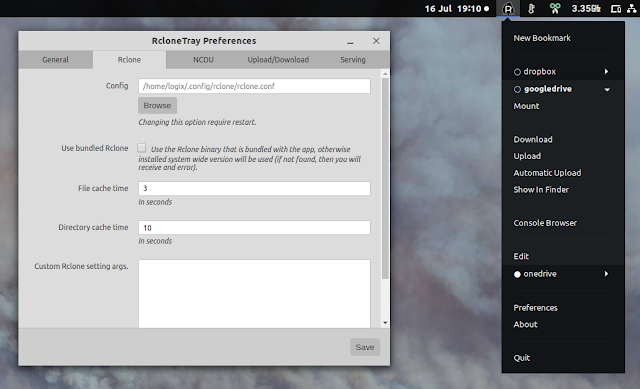

Now store the original key in a password manager and never save it otherwise or use it.
Using rclone backblaze install#
What you can do is install the b2 command line tool (1st party) and then do the following export B2_APPLICATION_KEY_ID=ī2 create-key safe listKeys,listAllBucketNames,listBuckets,readBuckets,writeBuckets,readBucketRetentions,writeBucketRetentions,readBucketEncryption,writeBucketEncryption,listFiles,readFiles,shareFiles,writeFiles,readFileLegalHolds,writeFileLegalHolds,readFileRetentions,writeFileRetentions What you can do is (a) generate a key that never allows for a real delete and (b) set up lifecycle rules so that things stick around for a day or two. You cannot use B2's "object-lock" because it'll break the flow. You are protected with security through obscurity but that is a bad design. That means that in curr will be the latest and greatest look of your entire backup and in dated back directories, you will have all of the files that would have been deleted or modified. What you will have is a "reverse incremental" backup. Make that into backup.sh then do $ chmod +x backup.sh exclude "*.exe" `# Plus any other excludes` \ fast-list `# useful on bucket-remotes like B2` \ A libre FTP, SFTP, WebDAV, S3, Backblaze B2, Azure & OpenStack Swift browser. Make a simple script that looks like the following NOW=$(date +"%Y-%m-%dT%H%M%S%z") Rclone in a cron job to sync files nightly. If you need more info: $ rclone lsf -R $HOME -exclude "*.exe" This is a good test since it will help you identify issues and make sure you're getting all of the files you want. Let's also say you are backing up $HOME $ rclone size $HOME -exclude "*.exe" To increase threading you’ll need to use per-VM backup files. You can test what you have backed up pretty easily. Veeam This one is easyVeeam automatically uses up to 64 threads per VM (not to be confused with concurrent tasks ) when uploading to Backblaze B2. If you don't want to mess with it, just leave it alone. You can just copy everything or you can use filters to control it. You will use rclone to copy from a source "remote" (which will be your local file system) to B2. See later for ransomware protection guide too Step 2: Set up filters, etc. Read the 1001 different guides out there including the ones written by Backblaze on their blog.

Meaning if you don't use rclone's encryption, you can download your files with any other B2 compatible tool including the web interface.

Also, especially useful for the novice user, it uploads your files in a 1-1 manner. What it is is easy, robust, and sufficient. Is it is the smartest, best, most efficient, most featureful, fastest backup tool out there? Nope for every single one of them.
Using rclone backblaze update#
I could have small typos that make it fail but I can update it. WARNING: I am writing this without access to an easy test. This is not going to go into every single detail. This is really for /u/TroothBeToldPodcast who is having some trouble, and /u/TotallynotJohnSmith, but maybe it will help others.


 0 kommentar(er)
0 kommentar(er)
